Effect of CTAB on the Morphology of Sn-MOF and the Gas Sensing Performance of SnO2 with Different Crystal Phases for H2 Detection
Abstract
1. Introduction
2. Experimental Section
2.1. Synthesis and Preparation
2.2. Characterization
2.3. Gas Sensing Properties
3. Result and Discussion
3.1. Materials Characterization
3.2. XPS
3.3. Gas-Sensing Performance
3.4. Phase-Dependent Gas Sensing Behavior of SnO2
3.5. Gas Sensing Mechanism
4. Conclusions
Supplementary Materials
Author Contributions
Funding
Institutional Review Board Statement
Informed Consent Statement
Data Availability Statement
Conflicts of Interest
References
- Guo, J.; Chen, P. Interplay of Alkali, Transition Metals, Nitrogen, and Hydrogen in Ammonia Synthesis and Decomposition Reactions. Acc. Chem. Res. 2021, 54, 2434–2444. [Google Scholar] [CrossRef] [PubMed]
- Chen, Z.; Erwin, B.J.; Che, L. Hydrocracking of polyethylene to hydrocarbon fuels over Pt/USY catalysts: Assessment of the hydrogen donors. J. Clean. Prod. 2023, 424, 138861. [Google Scholar] [CrossRef]
- Singla, M.K.; Nijhawan, P.; Oberoi, A.S. Hydrogen fuel and fuel cell technology for cleaner future: A review. Environ. Sci. Pollut. Res. Int. 2021, 28, 15607–15626. [Google Scholar] [CrossRef] [PubMed]
- Boretti, A. Hydrogen internal combustion engines to 2030. Int. J. Hydrogen Energy 2020, 45, 23692–23703. [Google Scholar] [CrossRef]
- Tang, J.; Chu, M.-S.; Li, F.; Feng, C.; Liu, Z.-G.; Zhou, Y.-S. Development and progress on hydrogen metallurgy. Int. J. Min. Metmater. 2020, 27, 713–723. [Google Scholar] [CrossRef]
- Silva, S.F.; Coelho, L.; Frazao, O.; Santos, J.L.; Malcata, F.X. A Review of Palladium-Based Fiber-Optic Sensors for Molecular Hydrogen Detection. IEEE Sens. J. 2012, 12, 93–102. [Google Scholar] [CrossRef]
- Dey, A. Semiconductor metal oxide gas sensors: A review. Mat. Sci. Eng. B 2018, 229, 206–217. [Google Scholar] [CrossRef]
- Zhu, L.Y.; Ou, L.X.; Mao, L.W.; Wu, X.Y.; Liu, Y.P.; Lu, H.L. Advances in Noble Metal-Decorated Metal Oxide Nanomaterials for Chemiresistive Gas Sensors: Overview. Nanomicro Lett. 2023, 15, 89. [Google Scholar] [CrossRef]
- Wang, L.; Li, J.; Xu, C.; Yang, Z.; Tan, X.; Dong, Z.; Xu, L.; Zhang, D.; He, C. 2D SnSe2 micro-flower decorated with 0D In2O3 nanoparticles for low-temperature low-concentration TEA detection. Nano Mater. Sci. 2024, 6, 764–774. [Google Scholar] [CrossRef]
- Wang, W.; Cao, J.; Wang, D.; Zhang, R.; Zhang, Y.; Zhao, L. Insight into SnO2-based gas-sensitive materials and readout circuits for semiconductor gas sensors. Nano Mater. Sci. 2025, in press. [Google Scholar] [CrossRef]
- Ab Kadir, R.; Li, Z.; Sadek, A.Z.; Abdul Rani, R.; Zoolfakar, A.S.; Field, M.R.; Ou, J.Z.; Chrimes, A.F.; Kalantar-zadeh, K. Electrospun Granular Hollow SnO2 Nanofibers Hydrogen Gas Sensors Operating at Low Temperatures. J. Phys. Chem. C 2014, 118, 3129–3139. [Google Scholar] [CrossRef]
- Lu, S.; Zhang, Y.; Liu, J.; Li, H.-Y.; Hu, Z.; Luo, X.; Gao, N.; Zhang, B.; Jiang, J.; Zhong, A.; et al. Sensitive H2 gas sensors based on SnO2 nanowires. Sens. Actuators B 2021, 345, 130334. [Google Scholar] [CrossRef]
- Yin, X.-T.; Dastan, D.; Gity, F.; Li, J.; Shi, Z.; Alharbi, N.D.; Liu, Y.; Tan, X.-M.; Gao, X.-C.; Ma, X.-G.; et al. Gas sensing selectivity of SnO2-xNiO sensors for homogeneous gases and its selectivity mechanism: Experimental and theoretical studies. Sens. Actuators A 2023, 354, 114273. [Google Scholar] [CrossRef]
- Das, S.; Jayaraman, V. SnO2: A comprehensive review on structures and gas sensors. Prog. Mater Sci. 2014, 66, 112–255. [Google Scholar] [CrossRef]
- Wang, B.J.; Ma, S.Y. High response ethanol gas sensor based on orthorhombic and tetragonal SnO2. Vacuum 2020, 177, 113851. [Google Scholar] [CrossRef]
- Zhang, Y.; Yu, X.; Hou, Y.; Liu, C.; Xie, G.; Chen, X. Current research status of MOF materials for catalysis applications. Mol. Catal. 2024, 555, 113851. [Google Scholar] [CrossRef]
- Khan, M.; Akmal, Z.; Tayyab, M.; Mansoor, S.; Zeb, A.; Ye, Z.; Zhang, J.; Wu, S.; Wang, L. MOFs materials as photocatalysts for CO2 reduction: Progress, challenges and perspectives. Carbon Capture Sci. Technol. 2024, 11, 100191. [Google Scholar] [CrossRef]
- Huang, J.-M.; Zhang, X.-D.; Huang, J.-Y.; Zheng, D.-S.; Xu, M.; Gu, Z.-Y. MOF-based materials for electrochemical reduction of carbon dioxide. Coord. Chem. Rev. 2023, 494, 215333. [Google Scholar] [CrossRef]
- Liu, M.; Wang, L.; Ren, S.; Bai, B.; Chai, S.; He, C.; Zheng, C.; Yin, X.; Li, F. Preparation, improvement, and application of metal–organic framework-based sensing materials for gas leakage and emission: A review. Nano Mater. Sci. 2025, in press. [Google Scholar] [CrossRef]
- Iravani, S. Surfactant-free synthesis of metal and metal oxide nanomaterials: A perspective. RSC Sustain. 2023, 1, 72–82. [Google Scholar] [CrossRef]
- Sanei, S.A.; Masoudpanah, S.M.; Bafghi, M.S. CTAB-assisted solvothermal growth of CuCo2S4 on nickel foam for high-performance symmetric supercapacitor. J. Energy Storage 2023, 73, 109130. [Google Scholar] [CrossRef]
- Zhu, L.; Wang, J.; Liu, J.; Chen, X.; Xu, Z.; Ma, Q.; Wang, Z.; Liang, J.; Li, S.; Yan, W. Designing highly sensitive formaldehyde sensors via A-site cation deficiency in LaFeO3 hollow nanofibers. Appl. Surf. Sci. 2022, 590, 153085. [Google Scholar] [CrossRef]
- Zhu, L.; Zhang, J.; Wang, J.; Liu, J.; Yan, W. Hierarchical Heterojunctions of Metal Sulfide WS2 Nanosheets/Metal Oxide In2O3 Nanofibers for an Efficient Detection of Formaldehyde. Nanomaterials 2024, 14, 1702. [Google Scholar] [CrossRef] [PubMed]
- Forgan, R.S. Modulated self-assembly of metal-organic frameworks. Chem. Sci. 2020, 11, 4546–4562. [Google Scholar] [CrossRef]
- Kou, H.; Shao, T.; Dong, J.; Cheng, Y.; Zhang, F.; Guo, J.; Liu, X.; Wang, X. Ethanol sensor built on a SnO2/In2O3 composite generated from MOF. Sens. Actuators B 2023, 396, 134628. [Google Scholar] [CrossRef]
- Zhang, X.; Huang, H.; Zhang, Y.; Liu, D.; Tong, N.; Lin, J.; Chen, L.; Zhang, Z.; Wang, X. Phase Transition of Two-Dimensional beta-Ga2O3 Nanosheets from Ultrathin gamma-Ga2O3 Nanosheets and Their Photocatalytic Hydrogen Evolution Activities. ACS Omega 2018, 3, 14469–14476. [Google Scholar] [CrossRef]
- Shek, C.H.; Lai, J.K.L.; Lin, G.M.; Zheng, Y.F.; Liu, W.H. Nanomicrostructure, chemical stability and abnormal transformation in ultrafine particles of oxidized tin. J. Phys. Chem. Solids 1997, 58, 13–17. [Google Scholar] [CrossRef]
- Choi, P.G.; Izu, N.; Shirahata, N.; Masuda, Y. Improvement of sensing properties for SnO2 gas sensor by tuning of exposed crystal face. Sens. Actuators B 2019, 296, 126655. [Google Scholar] [CrossRef]
- Fondell, M.; Gorgoi, M.; Boman, M.; Lindblad, A. An HAXPES study of Sn, SnS, SnO and SnO2. J. Electron. Spectrosc. Relat. Phenom. 2014, 195, 195–199. [Google Scholar] [CrossRef]
- Bai, H.; Feng, C.; Chen, Y.; Du, Y.; Feng, Y.; Liu, K.; Yan, Y.; Liu, J.; Zhang, B.; Wang, J.; et al. Room temperature gas sensor based on porous NiO nanoplates modified with rGO nanosheets and SnO2 nanoparticles for accurate and rapid ppb-level NO2 detection. Nano Mater. Sci. 2025, in press. [Google Scholar] [CrossRef]
- Zhang, X.; Sun, S.; Wang, H.; Lyu, J.; Yu, X.; Yang, B.; Yang, M.; Duan, Z.; Yang, Q.; Cui, J. Mechanism insight into twin-dependent photocatalysis in near-infrared light-responsive Cu2O nanocrystals with rich oxygen vacancies. Nano Mater. Sci. 2024, in press. [Google Scholar] [CrossRef]
- Jing, J.; Li, J.; Xue, Q.; Wang, P.; Li, W.; Meng, Y.; Zhan, Z.; Zhang, Y.; Li, F. Stable Pt/PtO2-enhanced 3D inverse opal SnO2 gas sensor for high sensitivity and fast H2 sensing at low temperatures. Sens. Actuators B 2025, 431, 13746. [Google Scholar] [CrossRef]
- Yang, L.; Fan, W.; Li, Y.; Wei, L.; Zhao, X. Pressure-induced ferroelastic phase transition in SnO2 from density functional theory. J. Chem. Phys. 2014, 140, 164706. [Google Scholar] [CrossRef] [PubMed]
- Khomarloo, N.; Mohsenzadeh, E.; Gidik, H.; Bagherzadeh, R.; Latifi, M. Overall perspective of electrospun semiconductor metal oxides as high-performance gas sensor materials for NOx detection. RSC Adv. 2024, 14, 7806–7824. [Google Scholar] [CrossRef]
- Yang, W.; Wan, P.; Jia, M.; Hu, J.; Guan, Y.; Feng, L. A novel electronic nose based on porous In2O3 microtubes sensor array for the discrimination of VOCs. Biosens. Bioelectron. 2015, 64, 547–553. [Google Scholar] [CrossRef]
- Wang, Z.; Li, P.; Feng, B.; Feng, Y.; Cheng, D.; Wei, J. Wireless Gas Sensor Based on the Mesoporous ZnO-SnO2 Heterostructure Enables Ultrasensitive and Rapid Detection of 3-Methylbutyraldehyde. ACS Sens. 2024, 9, 2585–2595. [Google Scholar] [CrossRef]
- Xue, N.; Zhang, Q.; Zhang, S.; Zong, P.; Yang, F. Highly Sensitive and Selective Hydrogen Gas Sensor Using the Mesoporous SnO2 Modified Layers. Sensors 2017, 17, 2351. [Google Scholar] [CrossRef]
- Umar, A.; Ammar, H.Y.; Kumar, R.; Almas, T.; Ibrahim, A.A.; AlAssiri, M.S.; Abaker, M.; Baskoutas, S. Efficient H2 gas sensor based on 2D SnO2 disks: Experimental and theoretical studies. Int. J. Hydrogen Energy 2020, 45, 26388–26401. [Google Scholar] [CrossRef]
- Yin, X.-T.; Li, J.; Dastan, D.; Zhou, W.-D.; Garmestani, H.; Alamgir, F.M. Ultra-high selectivity of H2 over CO with a p-n nanojunction based gas sensors and its mechanism. Sens. Actuators B 2020, 319, 128330. [Google Scholar] [CrossRef]
- Majumdar, S.; Nag, P.; Devi, P.S. Enhanced performance of CNT/SnO2 thick film gas sensors towards hydrogen. Mater. Chem. Phys. 2014, 147, 79–85. [Google Scholar] [CrossRef]
- Zhang, H.; Li, Z.; Liu, L.; Xu, X.; Wang, Z.; Wang, W.; Zheng, W.; Dong, B.; Wang, C. Enhancement of hydrogen monitoring properties based on Pd–SnO2 composite nanofibers. Sens. Actuators B 2010, 147, 111–115. [Google Scholar] [CrossRef]
- Duan, P.; Duan, Q.; Peng, Q.; Jin, K.; Sun, J. Design of ultrasensitive gas sensor based on self-assembled Pd-SnO2/rGO porous ternary nanocomposites for ppb-level hydrogen. Sens. Actuators B 2022, 369, 132280. [Google Scholar] [CrossRef]
- Anand, K.; Singh, O.; Singh, M.P.; Kaur, J.; Singh, R.C. Hydrogen sensor based on graphene/ZnO nanocomposite. Sens. Actuators B 2014, 195, 409–415. [Google Scholar] [CrossRef]
- Ding, W.; Ansari, N.; Yang, Y.; Bachagha, K. Superiorly sensitive and selective H2 sensor based on p-n heterojunction of WO3–CoO nanohybrids and its sensing mechanism. Int. J. Hydrogen Energy 2021, 46, 28823–28837. [Google Scholar] [CrossRef]
- Suman, P.H.; Felix, A.A.; Tuller, H.L.; Varela, J.A.; Orlandi, M.O. Comparative gas sensor response of SnO2, SnO and Sn3O4 nanobelts to NO2 and potential interferents. Sens. Actuators B 2015, 208, 122–127. [Google Scholar] [CrossRef]
- Krishna, K.G.; Umadevi, G.; Parne, S.; Pothukanuri, N. Zinc oxide based gas sensors and their derivatives: A critical review. J. Mater. Chem. C 2023, 11, 3906–3925. [Google Scholar] [CrossRef]
- Shah, S.; Hussain, S.; Din, S.T.U.; Shahid, A.; Amu-Darko, J.N.O.; Wang, M.; Tianyan, Y.; Liu, G.; Qiao, G. A review on In2O3 nanostructures for gas sensing applications. J. Environ. Chem. Eng. 2024, 12, 11253. [Google Scholar] [CrossRef]
- Huang, M.; Wang, S.; Fu, H.; Shao, H.; Wang, Y.; Yu, K.; Huang, Y.; Jv, Z.; Wang, L. An efficient vapor-phase processing method derived mesoporous N-C@SnO2-Co3O4 hollow nanoboxes with abundant surface oxygen vacancy for highly improved gas sensing application. J. Alloys Compd. 2021, 863, 158341. [Google Scholar] [CrossRef]
- Kumar, V.; Gautam, D.; Gautam, Y.K.; Kumar, A.; Adalati, R.; Sanger, A.; Kang, S.B.; Jain, R.K. Experimental and theoretical studies of sputter deposited pure SnO2 thin films for high selective and humidity-tolerant H2 gas sensor. J. Mater. Sci. Mater. Electron. 2024, 35, 1957. [Google Scholar] [CrossRef]
- Zhang, Z.; Zhang, D.; Yue, C.; Liu, Z.; Mu, Y.; Yang, Z.; Dastan, D.; Zhang, X.; Yin, X.-T.; Ma, X. High sensitivity and surface mechanism of MOFs-derived metal oxide Co3O4-SnO2 hollow spheres to ethanol. J. Alloys Compd. 2023, 962, 171182. [Google Scholar] [CrossRef]

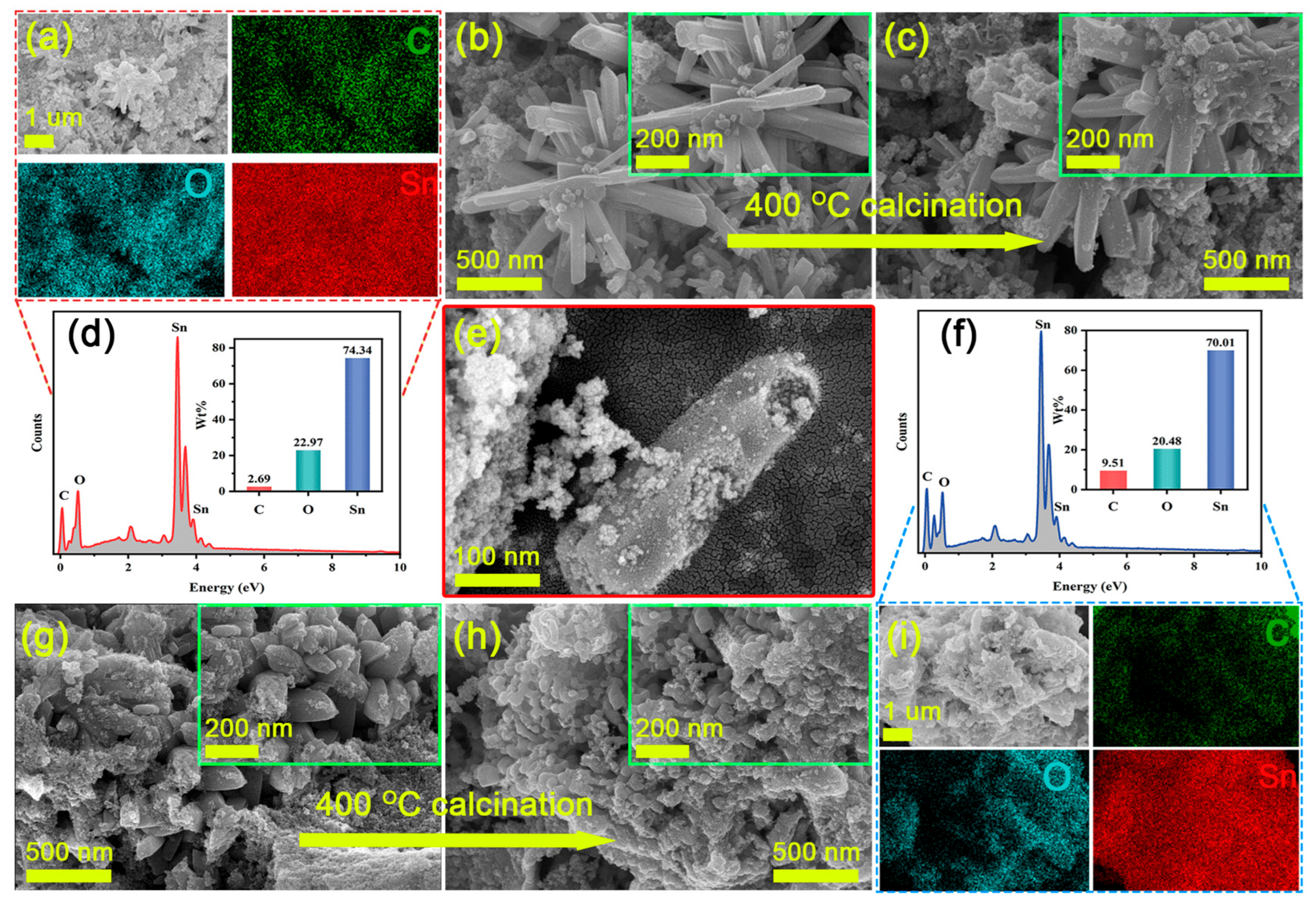
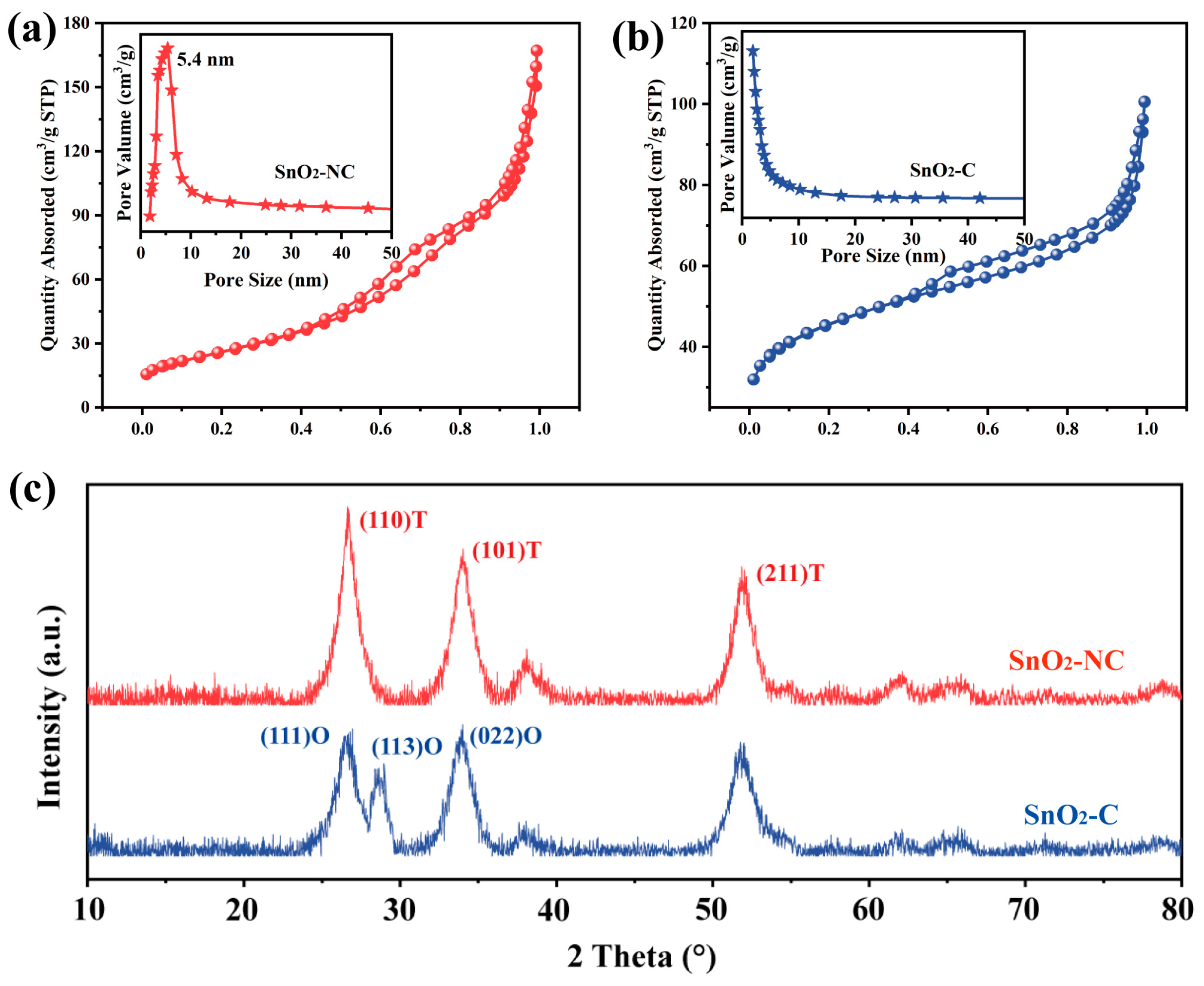
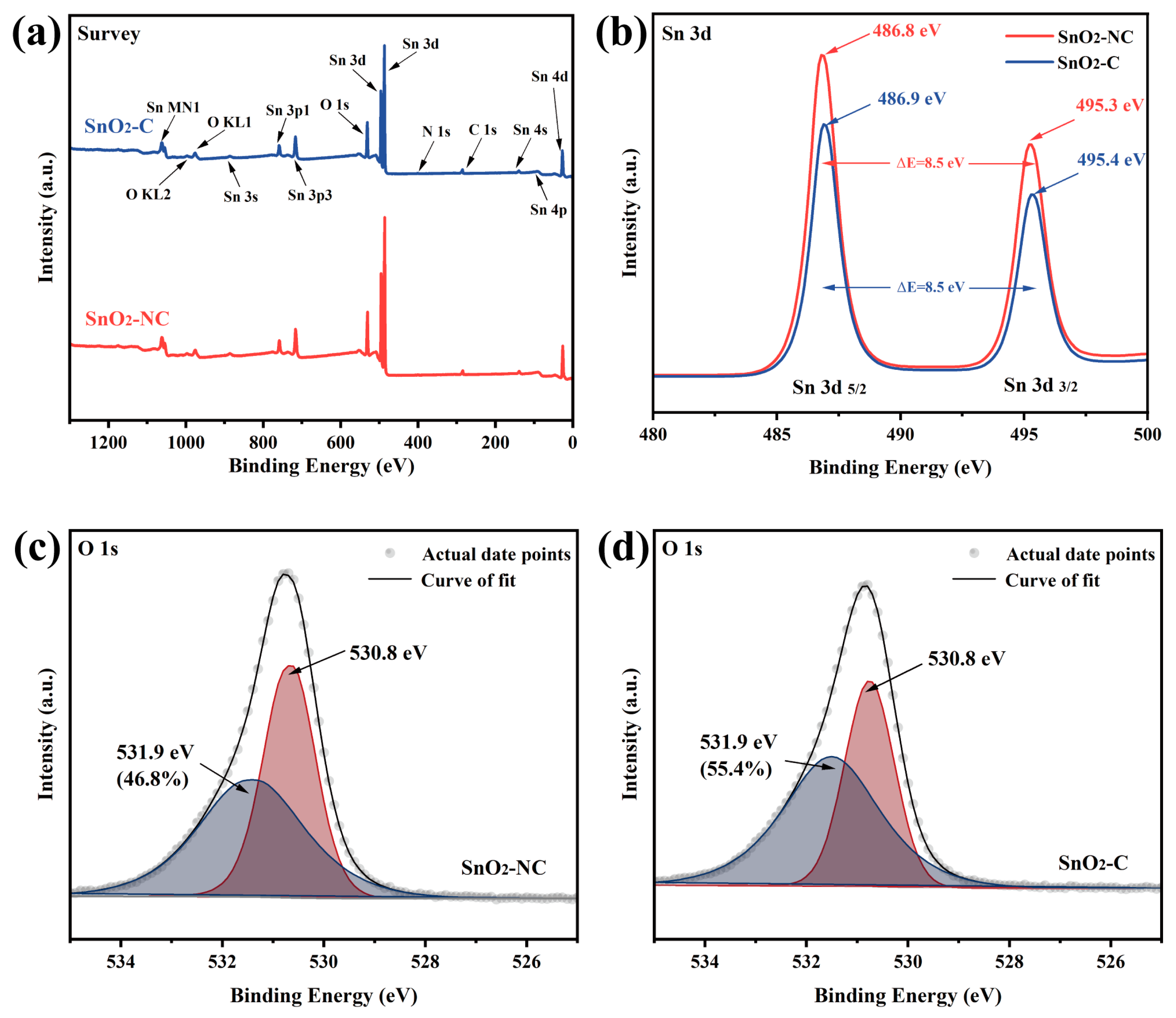
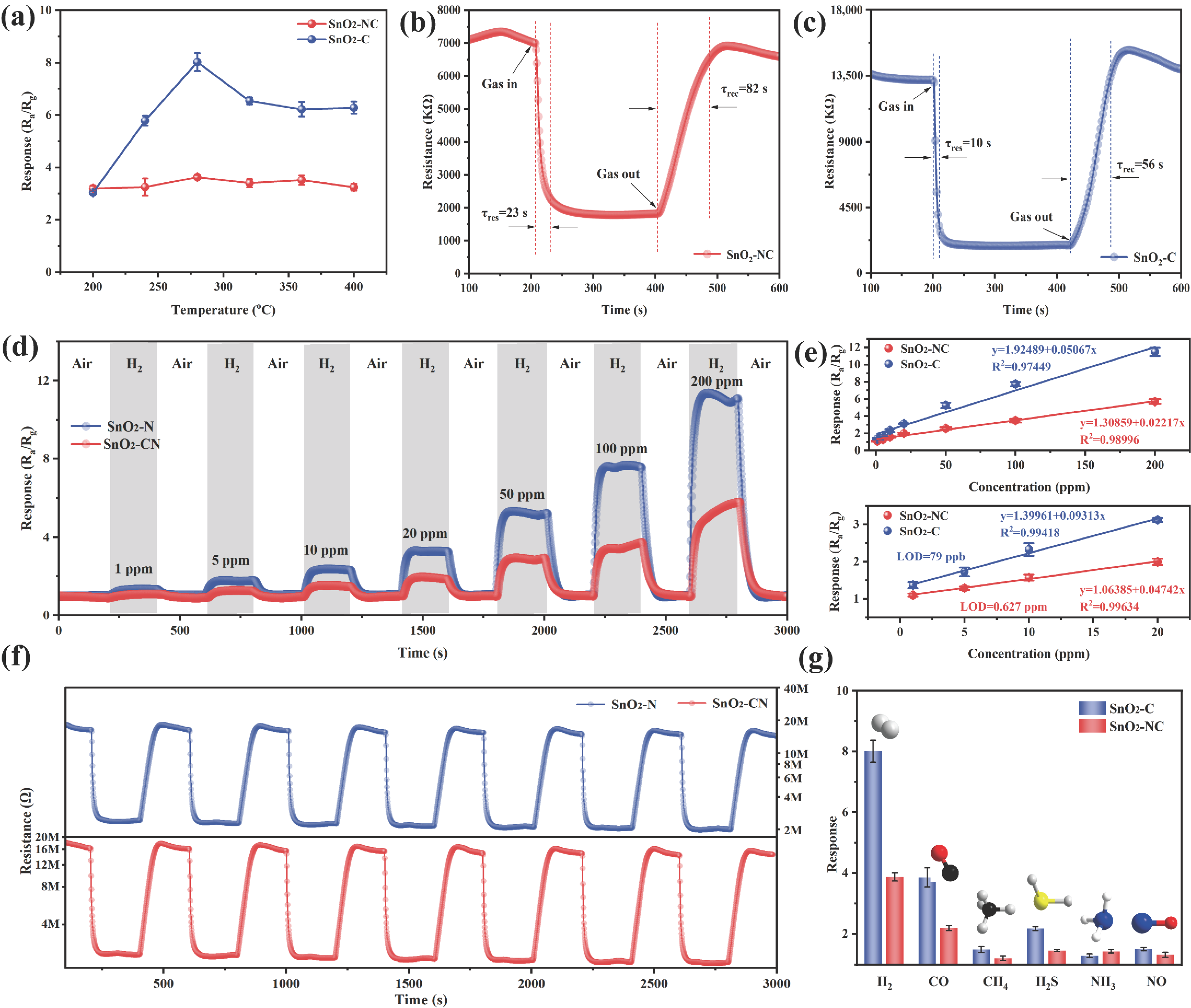
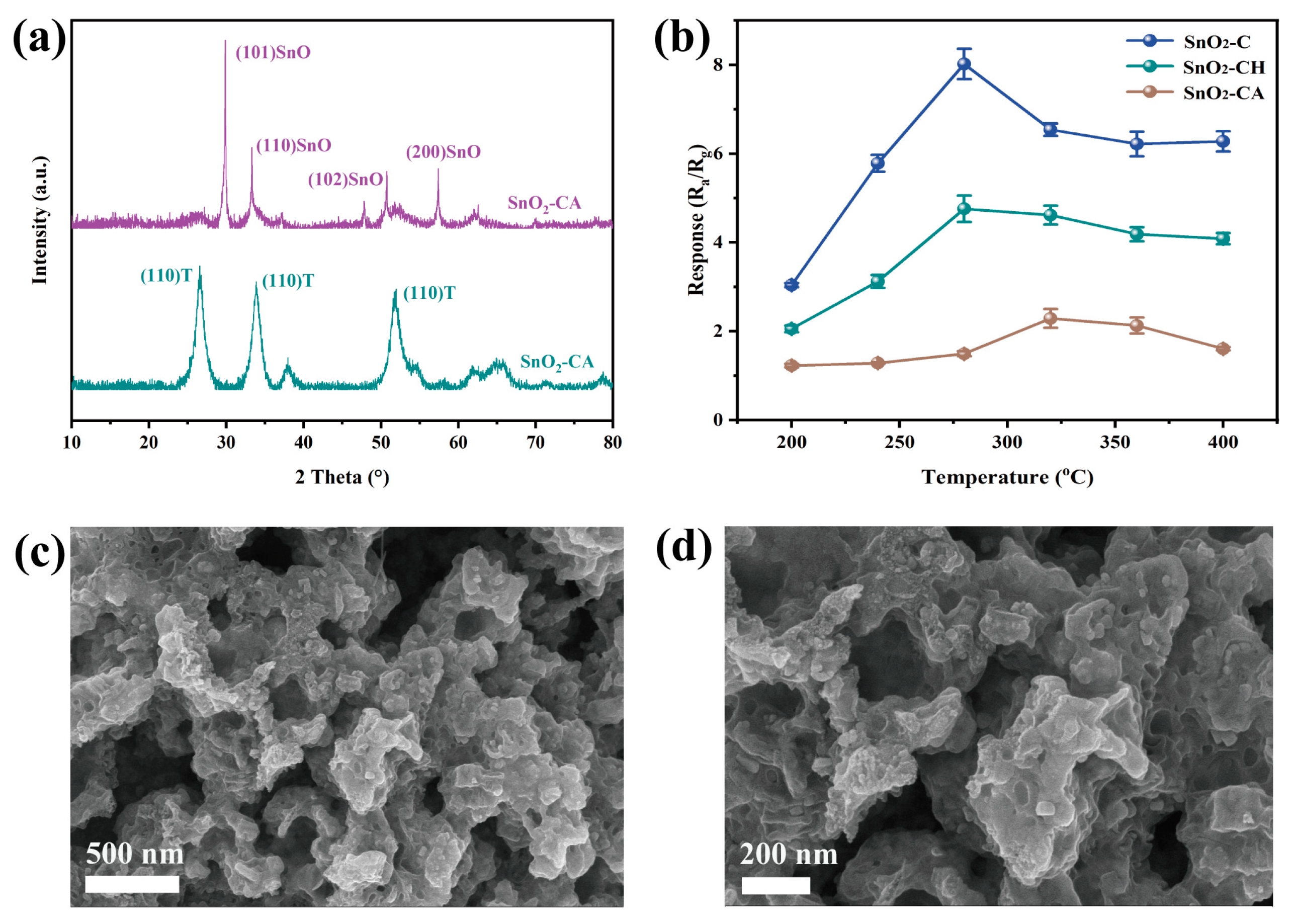
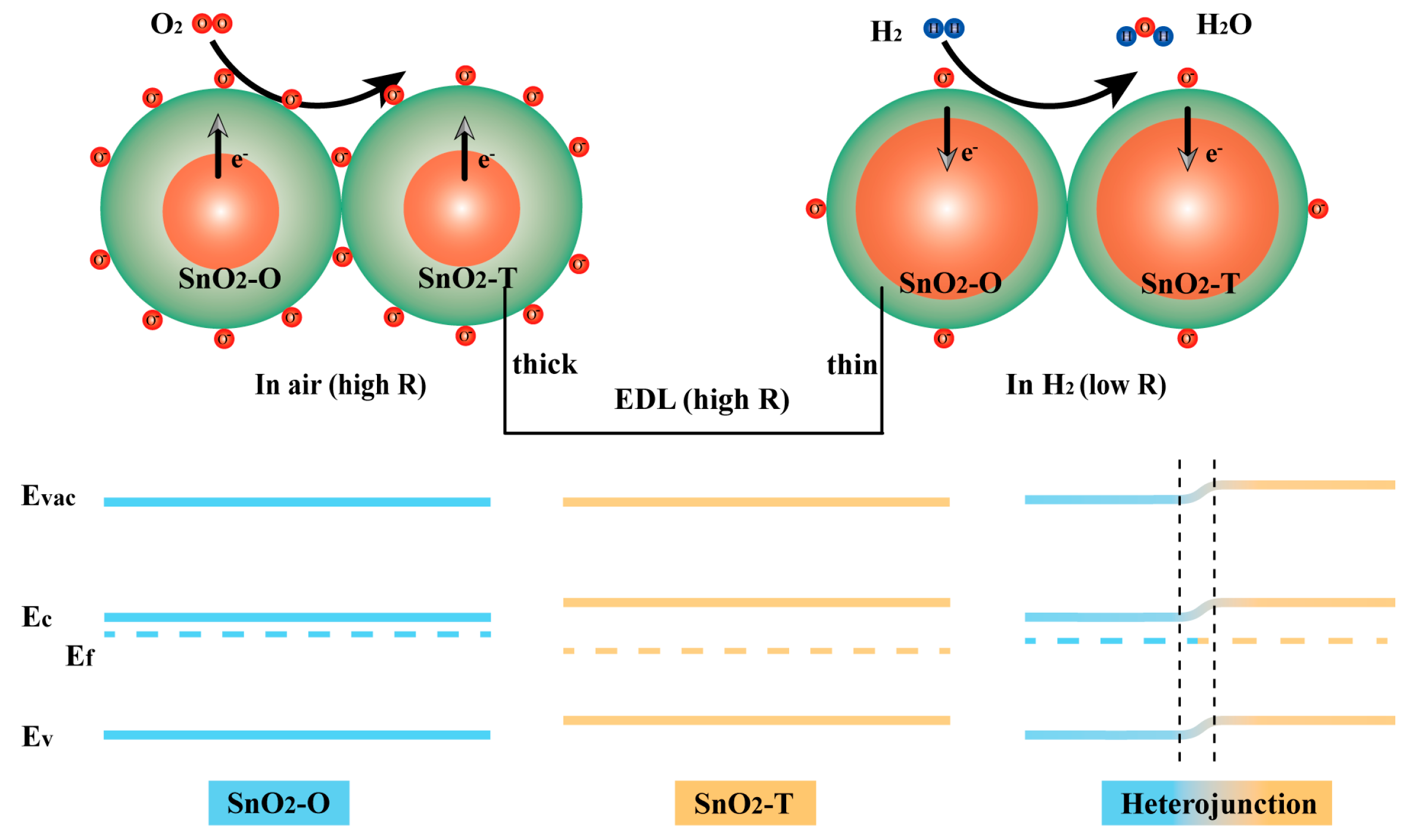
| Material | Temp. (°C) | Response (Ra/Rg) | Conc. (ppm) | τres/τrec | LOD | Ref. |
|---|---|---|---|---|---|---|
| SnO2-C | 280 | 7.73 | 100 | 10/56 | 79 ppb | This work |
| SnO2-NC | 280 | 3.75 | 100 | 23/82 | 0.627 ppm | This work |
| SnO2 film | 400 | ~23 | 1000 | 89/>500 | / | [37] |
| 2D SnO2 | 400 | ~15 | 100 | 4/331 | / | [38] |
| SnO2-Co3O4 | 350 | 4.5 | 500 | / | / | [39] |
| CNT@SnO2 | 350 | 8% | 97.13% | 20/110 | / | [40] |
| Pd/SnO2 nanowires | 280 | 8.2 | 100 | 9/- | 4.5 ppm | [41] |
| Pd-SnO2/rGO | 360 | 2.4 | 200 | 24.4/25.8 | 0.365 ppm | [42] |
| rGO/ZnO | 150 | 3.5 | 200 | 22/90 | / | [43] |
| WO3 | 250 | 4.8 | 100 | >100 | 0.25 ppm | [44] |
Disclaimer/Publisher’s Note: The statements, opinions and data contained in all publications are solely those of the individual author(s) and contributor(s) and not of MDPI and/or the editor(s). MDPI and/or the editor(s) disclaim responsibility for any injury to people or property resulting from any ideas, methods, instructions or products referred to in the content. |
© 2025 by the authors. Licensee MDPI, Basel, Switzerland. This article is an open access article distributed under the terms and conditions of the Creative Commons Attribution (CC BY) license (https://creativecommons.org/licenses/by/4.0/).
Share and Cite
Liu, M.; Wang, L.; Ren, S.; Bai, B.; Chai, S.; He, C.; Zheng, C.; Li, X.; Yin, X.; Xu, C.C. Effect of CTAB on the Morphology of Sn-MOF and the Gas Sensing Performance of SnO2 with Different Crystal Phases for H2 Detection. Chemosensors 2025, 13, 192. https://doi.org/10.3390/chemosensors13050192
Liu M, Wang L, Ren S, Bai B, Chai S, He C, Zheng C, Li X, Yin X, Xu CC. Effect of CTAB on the Morphology of Sn-MOF and the Gas Sensing Performance of SnO2 with Different Crystal Phases for H2 Detection. Chemosensors. 2025; 13(5):192. https://doi.org/10.3390/chemosensors13050192
Chicago/Turabian StyleLiu, Manyi, Liang Wang, Shan Ren, Bofeng Bai, Shouning Chai, Chi He, Chunli Zheng, Xinzhe Li, Xitao Yin, and Chunbao Charles Xu. 2025. "Effect of CTAB on the Morphology of Sn-MOF and the Gas Sensing Performance of SnO2 with Different Crystal Phases for H2 Detection" Chemosensors 13, no. 5: 192. https://doi.org/10.3390/chemosensors13050192
APA StyleLiu, M., Wang, L., Ren, S., Bai, B., Chai, S., He, C., Zheng, C., Li, X., Yin, X., & Xu, C. C. (2025). Effect of CTAB on the Morphology of Sn-MOF and the Gas Sensing Performance of SnO2 with Different Crystal Phases for H2 Detection. Chemosensors, 13(5), 192. https://doi.org/10.3390/chemosensors13050192






_Xu.png)


